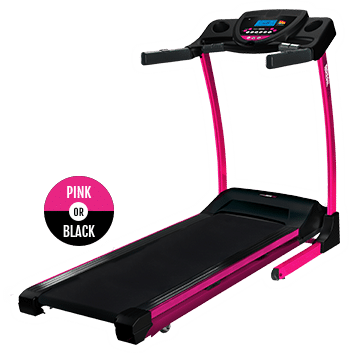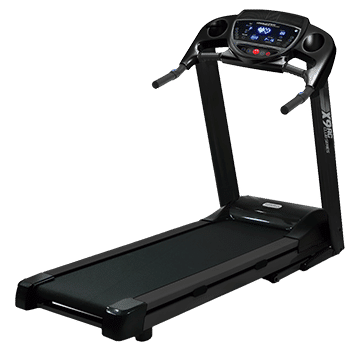Treadmills
BUY NOW, PAY LATER - INTEREST FREE
Breakfree Treadmill
1.5HP DC MOTOR… optimum
performance, high torque!!!
Long walking stride
(41cm x 124cm mat)
Up to 14kph jogging speed
Connect music through your speakers
Stay cool with a console fan
2 cushioning systems – for bounce-back
support and ultimate joint protection!
Auto Incline for more hills to tone those glutes!
X9 AC Club Series Treadmill
2.5HP Health Club AC Motor – commercial
quality, smoother ride!!!
Larger deck, for a long running stride
(48cm x 140cm mat)
Up to 20kph speed for a serious run
Play your favourite tunes in
BLUETOOTH BASS-FLEX SOUND
3 Heart Rate Control programs so you
always work in your fat burning zone
Stay cool with a console fan
2 cushioning systems – for bounce-back
support and ultimate joint protection!
Auto Incline for more hills to tone those glutes!
Connect to the iConsole+ App – feedback & tracking!
Never lose charge – with a handy USB
charger built into the console
Which CardioTech Treadmill is right for you?
The first consideration when choosing the right CardioTech treadmill for you is whether you intend to walk or run as your chosen routine. Even if you start by walking but intend to eventually be running then choose the right treadmill for this. Running requires a larger motor and tread speed together with a longer deck size to cater for a longer stride. If you are over 6 foot then you may need a larger deck regardless of your intended usage.
All of our CardioTech treadmills have an incline option, so even if you don’t intend to up the ante on your treadmill workout straight away the option is there for you.
Music options are included in all of our CardioTech treadmills but if you want the Bluetooth option you will need to check each treadmill’s extras.
Programs and apps are available to help you get the most out of your treadmill experience. Our CardioTech treadmills have a range of program and app options you should check out when choosing which is best for you.
Our CardioTech Club Series treadmill also offers the convenience of a USB port built into the console. If you want to keep your phone or tablet handy and powered up then this may be the best treadmill for you.
All of our CardioTech treadmills are great choices, now it is just up to you to decide which one is best for you.
Why choose a CardioTech Treadmill?
Some minimum specifications for a treadmill you should consider are the size of the motor, the size of the deck and the deck speed. All three of the CardioTech treadmills meet and/or exceed the recommended specifications for a treadmill to achieve the best weight loss and general fitness experience. The CardioTech cushioning systems can also help reduce impact on the legs by up to 40%. The CardioTech treadmills also include some of those favourite extras including music for your workout.

BUY NOW, PAY LATER

INTEREST FREE PAYMENT

fast delivery australia wide

no compromise warranty

same day
response time

australian
owned & operated
FAQs
Yes, there are a few companies that hire out running machines. They’ll deliver you a second hand model, usually for a 3 or 6 month commitment and at the end of that you’ll be given a choice to purchase with the rental fee coming off your payout figure. However, you’ll often end up paying a lot more for the machine than its finance price and it was a second-hand treadmill to begin with. We’d recommend our X9 AC Series treadmill.
If you’re hoping to start gradually and ease yourself into regular walking (and potentially one day a little jog) then you can’t go past the Breakfree Treadmill. It comes with all the class of our premium model, as well as top rated features like Heart Rate Control; a built-in speaker system; and console fan! If space is tight, this machine folds up vertically so takes no room at all. For as little as $10 a week you can pay off this machine, and choose from pink or high gloss black to suit your taste and style.
The preferred option for most people is “rent to buy” or “hire to own”. That’s when you pay the machine off over a few years but take delivery of your brand new treadmill straight away. National factory-direct companies that import and retail their own products are the most affordable way to do this. They have negotiated the best rates with finance companies that they pass on to you. For example, CardioTech has partnered with Humm Finance and they have ‘no interest ever’ plans from as low as $10 a week.
For your safety and to extend the life of your treadmill we recommend regular maintenance. Check out our blog 5 Treadmill Maintenance Tips to Extend the Life of Your Treadmill
BreakFree & NightTrain Treadmill:
* RRP $1,695 Sale Price $1354 or available on payment plan through continuing credit provided by Certegy Ezi-Pay Pty Ltd. Fees, charges, terms, conditions and lending criteria apply. $10 per week plus $75 deposit. Minimum amount payable $1,709 over 38 months. Payment Plan Includes $45 Establishment Fee and $8 monthly Account Keeping Fee. Ask in-store for details or visit shophumm.com.au Delivery charge if applicable. Not available with any other offer.
X9AC Treadmill:
* RRP $3,495 Sale Price $2,995 or available on payment plan through continuing credit provided by Certegy Ezi-Pay Pty Ltd. Fees, charges, terms, conditions and lending criteria apply. $19.95 per week plus $110 deposit. Minimum amount payable $3,370 over 38 months. Payment Plan Includes $45 Establishment Fee and $8 monthly Account Keeping Fee. Ask in-store for details or visit shophumm.com.au Delivery charge if applicable. Not available with any other offer.




